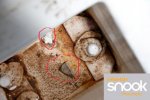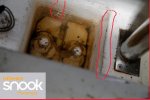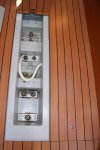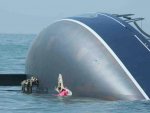You are using an out of date browser. It may not display this or other websites correctly.
You should upgrade or use an alternative browser.
You should upgrade or use an alternative browser.
Another 40.7
- Thread starter johndove
- Start date
snooks
Active member
And here are the keel bolts of one which hit something and kept her keel


these images © Graham Snook / http://grahamsnook.com


these images © Graham Snook / http://grahamsnook.com
haydude
New member
How did this happen?
JumbleDuck
Well-known member
Tell more ...
daveyw
Active member
I'm surprised the keel bolts only have very small doubler plates. Surely it would be better to spread the load over a somewhat larger area?
Also,is this hull a solid construction or foam cored? When you look at CR upturned hull it looks cored. This must result in some flexibility around the keel.
Also,is this hull a solid construction or foam cored? When you look at CR upturned hull it looks cored. This must result in some flexibility around the keel.
Last edited:
mainsail1
Well-known member
Its called Mickey Mouse construction in my view.
Vallich
New member
HunterWanderer
Member
Its called Mickey Mouse construction in my view.
+1
2.7 tons of keel concentrated in a bulb at the bottom and a draft of 2.35m .
Stork_III
Well-known member
Also here http://www.sailfastchicago.com/site/category/boating-disasters/page/2/
Keel lost after repeated pounding in shallow water on Lake Michigan, boat sank but keel and hull recovered later.
Rigger Mortice
N/A
Ran aground, tore the keel off, and lying in 5 feet of water?How did this happen?
30boat
N/A
Also here http://www.sailfastchicago.com/site/category/boating-disasters/page/2/
Keel lost after repeated pounding in shallow water on Lake Michigan, boat sank but keel and hull recovered later.
I'd expect something to break after such treatment.It's not indicative of any particular weakness in this case.
rudolph_hart
Active member
I'd expect something to break after such treatment.It's not indicative of any particular weakness in this case.
But, if you look at the link provided by Vallich and look at the photo of a 'stock 40.7,' read the comment about the keel attachment
"Keel-bolt pattern on a stock First 40.7, as seen from inside. Note that the keel’s attachment points are not tied directly into the structural bilge grid. Also, this is an exceptionally shallow bilge!"
It makes me glad that my Dehler (like all of them) has an integral steel frame glassed in the bottom of the boat that takes and spreads the keel load, and that my keel bolts are much further apart laterally than those in the photo. (shame there isn't a Smug smilie
snooks
Active member
"Keel-bolt pattern on a stock First 40.7, as seen from inside. Note that the keel’s attachment points are not tied directly into the structural bilge grid. Also, this is an exceptionally shallow bilge!"
It makes me glad that my Dehler (like all of them)
Most production boats are constructed this way - with the keel bolted through the solid laminate rather than the subframe. Charlie (the author of the sail piece) should know this, as it's the norm rather than the exception. Millions of boats are constructed this way. What you will probably find is that at the keel point the subframe is laminated in place and the bolts are on top of this lamination.
Ps I don't think Dehler use the steel subframe any more. Could be wrong, I'm on a train so don't have the PDF brochures with me.
30boat
N/A
Most production boats are constructed this way - with the keel bolted through the solid laminate rather than the subframe. Charlie (the author of the sail piece) should know this, as it's the norm rather than the exception. Millions of boats are constructed this way. What you will probably find is that at the keel point the subframe is laminated in place and the bolts are on top of this lamination.
Ps I don't think Dehler use the steel subframe any more. Could be wrong, I'm on a train so don't have the PDF brochures with me.
The fact that the washer plates are placed on top of the tabbing (laminating) that connects the grid to the bottom effectively ties them to the grid.It can be a very secure arrangement providing the laminating has been correctly specified.
lw395
Well-known member
It seems to me that you wouldn't want the keel bolt be compressing the box structure of the floors.
Another point is that once the bolts are weeping, the laminate is wide open to osmosis.
Another point is that once the bolts are weeping, the laminate is wide open to osmosis.
Sailfree
Well-known member
Most production boats are constructed this way - with the keel bolted through the solid laminate rather than the subframe. Charlie (the author of the sail piece) should know this, as it's the norm rather than the exception. Millions of boats are constructed this way. What you will probably find is that at the keel point the subframe is laminated in place and the bolts are on top of this lamination.
Ps I don't think Dehler use the steel subframe any more. Could be wrong, I'm on a train so don't have the PDF brochures with me.
Dehler 32 pdf mentions floor beams laminated into the hull to spread the loads. Not sure whether new owners hanse influenced this change.
GAJ
Member
Most production boats are constructed this way - with the keel bolted through the solid laminate rather than the subframe. Charlie (the author of the sail piece) should know this, as it's the norm rather than the exception. Millions of boats are constructed this way. What you will probably find is that at the keel point the subframe is laminated in place and the bolts are on top of this lamination.
Ps I don't think Dehler use the steel subframe any more. Could be wrong, I'm on a train so don't have the PDF brochures with me.
Snooks' and 30boat, indeed the bolts will be taken through the structural interior moulding and hull effectively clamping the two together in this vintage of build, earlier models such as the 1980s First 405 had the bolts going through just the hull and not the interior moulding but the hulls were then very much thicker then than they are now.
I believe that you are both mistaken in your statement regarding the matter of the interior being laminated to the hull on this particular brand of vessel and many other production boats. On this type of boat the interior moulding and structural floors are bonded to the hull with a bonding paste, somewhat akin to car body filler. This bonding material is very brittle. Some builders use the more expensive, massively stronger and flexible Plexus type materials but I believe they are in the minority. See the upper of Snooks' photos where you can clearly see two pieces of the brittle material that have broken away.
A light grounding at say 2 to 3 knots will flex the hull and liner, the rear of the keel kicks up and the front down with the result that the brittle bonding paste cracks therefore losing the structural bond between the hull and the liner. The flexible laminate usually returns to its original shape. Over time the continuous flexing movements around the damaged area extend the cracks in the bonding paste radially outward and, eventually this generally extends out as far as the back of the berths and often as far aft as the aft cabin and engine beds.
Bear in mind that this can happen without any significant outwardly visible signs. The first indication is usually, but not always, some crazing of gel coat on the floors and then as the weakness progresses by creaking and groaning and squeaking woodwork indicating that the boat is flexing. A gap can appear at the leading or aft edge of the keel to hull joint but this is not always the case particularly in the models that have a full interior liner. The boat can sag around the keel when placed on the hard and supported by the keel.
In Snooks' photos you can see what appears to be a vertical crack in the floor and de-lamination horizontally below the stainless support, to me this indicates that there will probably be much more extensive damage. I suspect that the boat in Snooks' photos has already been repaired rather poorly by the fact that brush marks in the flowcoat in the bilge area are clearly visible. Out of the factory this area would be a smooth gelcoat finish as it would be the outer face of the moulding and a a quality repairer would seek to obtain the same finish as the factory. See lower pic for original finish.



This total covering of the hull by the liner as shown in the lower pic also can hinder the locating of the source of a leak or damage in that area as neither the keel to hull joint nor the structural interior moulding to hull joint are visible to inspect. Water from a leak can run inside the liner and appear at a point nowhere near the source of the leak.
I am not bashing this type of boat as I have owned a number myself and been perfectly happy with them but I do think that many owners are blissfully unaware of the potential for such problems and perhaps it would be advantageous if they were made aware so that they can keep a look out for any potential failure.
That said the constant income I have derived over the years repairing such damage has been most welcome so I wouldn't want people to be too careful.
30boat
N/A
Snooks' and 30boat, indeed the bolts will be taken through the structural interior moulding and hull effectively clamping the two together in this vintage of build, earlier models such as the 1980s First 405 had the bolts going through just the hull and not the interior moulding but the hulls were then very much thicker then than they are now.
I believe that you are both mistaken in your statement regarding the matter of the interior being laminated to the hull on this particular brand of vessel and many other production boats. On this type of boat the interior moulding and structural floors are bonded to the hull with a bonding paste, somewhat akin to car body filler. This bonding material is very brittle. Some builders use the more expensive, massively stronger and flexible Plexus type materials but I believe they are in the minority. See the upper of Snooks' photos where you can clearly see two pieces of the brittle material that have broken away.
A light grounding at say 2 to 3 knots will flex the hull and liner, the rear of the keel kicks up and the front down with the result that the brittle bonding paste cracks therefore losing the structural bond between the hull and the liner. The flexible laminate usually returns to its original shape. Over time the continuous flexing movements around the damaged area extend the cracks in the bonding paste radially outward and, eventually this generally extends out as far as the back of the berths and often as far aft as the aft cabin and engine beds.
Bear in mind that this can happen without any significant outwardly visible signs. The first indication is usually, but not always, some crazing of gel coat on the floors and then as the weakness progresses by creaking and groaning and squeaking woodwork indicating that the boat is flexing. A gap can appear at the leading or aft edge of the keel to hull joint but this is not always the case particularly in the models that have a full interior liner. The boat can sag around the keel when placed on the hard and supported by the keel.
In Snooks' photos you can see what appears to be a vertical crack in the floor and de-lamination horizontally below the stainless support, to me this indicates that there will probably be much more extensive damage. I suspect that the boat in Snooks' photos has already been repaired rather poorly by the fact that brush marks in the flowcoat in the bilge area are clearly visible. Out of the factory this area would be a smooth gelcoat finish as it would be the outer face of the moulding and a a quality repairer would seek to obtain the same finish as the factory. See lower pic for original finish.
View attachment 42911
View attachment 42910
View attachment 42909
This total covering of the hull by the liner as shown in the lower pic also can hinder the locating of the source of a leak or damage in that area as neither the keel to hull joint nor the structural interior moulding to hull joint are visible to inspect. Water from a leak can run inside the liner and appear at a point nowhere near the source of the leak.
I am not bashing this type of boat as I have owned a number myself and been perfectly happy with them but I do think that many owners are blissfully unaware of the potential for such problems and perhaps it would be advantageous if they were made aware so that they can keep a look out for any potential failure.
That said the constant income I have derived over the years repairing such damage has been most welcome so I wouldn't want people to be too careful.
I completely aggree with you.I was talking generally and not about this particular type of boat.I've always been extremely critical of Beneteau's,and now Jeanneau's method of building.I've seen by myself the inner liner crushed by the bolts on two different Beneteaux,a 26 and a 39(I think it was a 39).I would never buy a modern Benetau just because of that characteristic despite the fact that tere are thousands ou there sailing with no problems.Maybe they haven't hit anything yet or have and didn't tell.
Sailfree
Well-known member
GAF
Thanks for an informative post.
I bought my Jeanneau 43 in 2005 when I heard they were stopping production. I liked the Jeanneau because the internal frame grid is exposed and not the inner hull bonded to the outer. For economy I believe nearly all production boats now use a bonded inner hull so I feel I am guilty of joining they don't build them like they used to brigade!
With your experience of repairing a number of these would you buy a production AWB with bonded inner hull?
Thanks for an informative post.
I bought my Jeanneau 43 in 2005 when I heard they were stopping production. I liked the Jeanneau because the internal frame grid is exposed and not the inner hull bonded to the outer. For economy I believe nearly all production boats now use a bonded inner hull so I feel I am guilty of joining they don't build them like they used to brigade!
With your experience of repairing a number of these would you buy a production AWB with bonded inner hull?
Other threads that may be of interest
- Replies
- 5
- Views
- 374
- Replies
- 4
- Views
- 137
- Replies
- 8
- Views
- 290
- Replies
- 9
- Views
- 468

